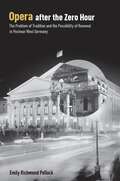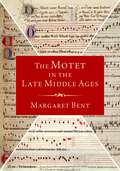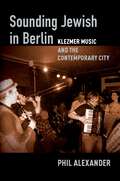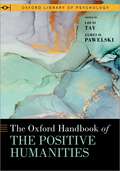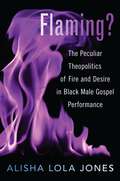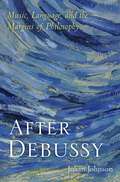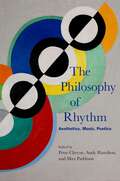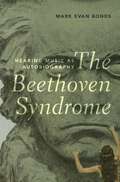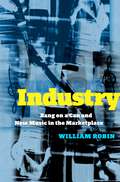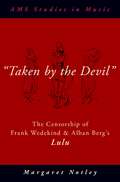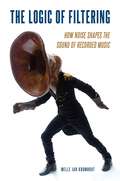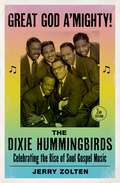- Table View
- List View
Teaching Music to Students with Autism
by Alice M. Hammel Ryan M. HouriganTeaching Music to Students with Autism is a comprehensive practical guide for music educators who work with students with autism. Authors and veteran music educators Alice M. Hammel and Ryan M. Hourigan offer an approach centered in inclusion designed for music educators, music teacher educators, and all those who have an interest in the education of students with autism. In this second edition, the authors offer fully up-to-date information on the diagnosis of autism, advocating for students and music programs, and creating and maintaining a team-approach when working with colleagues. A significant portion of the book is focused on understanding the communication, cognition, behavior, sensory, and socialization challenges inherent in students with autism and ways to structure classroom experiences and learning opportunities for all students. A chapter of classroom snapshots (vignettes) written by teachers in the field of music education provides additional opportunities to transfer information to 'real life' situations. Finally, the book offers a chapter of print and web resources for further study.
Opera After the Zero Hour: The Problem of Tradition and the Possibility of Renewal in Postwar West Germany
by Emily Richmond PollockOpera After the Zero Hour: The Problem of Tradition and the Possibility of Renewal in Postwar West Germany presents opera as a site for the renegotiation of tradition in a politically fraught era of rebuilding. Though the "Zero Hour" put a rhetorical caesura between National Socialism and postwar West Germany, the postwar era was characterized by significant cultural continuity with the past. With nearly all of the major opera houses destroyed and a complex relationship to the competing ethics of modernism and restoration, opera was a richly contested art form, and the genre's reputed conservatism was remarkably multi-faceted. Author Emily Richmond Pollock explores how composers developed different strategies to make new opera "new" while still deferring to historical conventions, all of which carried cultural resonances of their own. Diverse approaches to operatic tradition are exemplified through five case studies in works by Boris Blacher, Hans Werner Henze, Carl Orff, Bernd Alois Zimmermann, and Werner Egk. Each opera alludes to a distinct cultural or musical past, from Greek tragedy to Dada, bel canto to Berg. Pollock's discussions of these pieces draw on source studies, close readings, unpublished correspondence, institutional history, and critical commentary to illuminate the politicized artistic environment that influenced these operas' creation and reception. The result is new insight into how the particular opposition between a conservative genre and the idea of the "Zero Hour" motivated the development of opera's social, aesthetic, and political value after World War II.
Opera After the Zero Hour: The Problem of Tradition and the Possibility of Renewal in Postwar West Germany
by Emily Richmond PollockOpera After the Zero Hour: The Problem of Tradition and the Possibility of Renewal in Postwar West Germany presents opera as a site for the renegotiation of tradition in a politically fraught era of rebuilding. Though the "Zero Hour" put a rhetorical caesura between National Socialism and postwar West Germany, the postwar era was characterized by significant cultural continuity with the past. With nearly all of the major opera houses destroyed and a complex relationship to the competing ethics of modernism and restoration, opera was a richly contested art form, and the genre's reputed conservatism was remarkably multi-faceted. Author Emily Richmond Pollock explores how composers developed different strategies to make new opera "new" while still deferring to historical conventions, all of which carried cultural resonances of their own. Diverse approaches to operatic tradition are exemplified through five case studies in works by Boris Blacher, Hans Werner Henze, Carl Orff, Bernd Alois Zimmermann, and Werner Egk. Each opera alludes to a distinct cultural or musical past, from Greek tragedy to Dada, bel canto to Berg. Pollock's discussions of these pieces draw on source studies, close readings, unpublished correspondence, institutional history, and critical commentary to illuminate the politicized artistic environment that influenced these operas' creation and reception. The result is new insight into how the particular opposition between a conservative genre and the idea of the "Zero Hour" motivated the development of opera's social, aesthetic, and political value after World War II.
The Motet in the Late Middle Ages
by Margaret BentA unique capacity of measured polyphony is to give precisely fixed places not only to musical notes, but also to individual words in relation to them and each other. The Motet in the Late Middle Ages offers innovative approaches to the equal partnership of music and texts in motets of the fourteenth century and beyond, showcasing the imaginative opportunities afforded by this literal kind of intertextuality, and yielding a very different narrative from the common complaint that different simultaneous texts make motets incomprehensible. As leading musicologist Margaret Bent asserts, they simply require a different approach to preparation and listening. In this book, Bent examines the words and music of motets from many different angles: foundational verbal quotations and pre-existent chant excerpts and their contexts, citations both of words and music from other compositions, function, dating, structure, theory, and number symbolism. Individual studies of these original creations tease out a range of strategies, ingenuity, playfulness, striking juxtapositions, and even subversion. Half of the thirty-two chapters consist of new material; the other half are substantially revised and updated versions of previously published articles and chapters, organized into seven Parts. With new analyses of text and music together, new datings, new attributions, and new hypotheses about origins and interrelationships, Bent uncovers little-explored dimensions, provides a window into the craft and thought processes of medieval composers, and opens up many directions for future work.
The Motet in the Late Middle Ages
by Margaret BentA unique capacity of measured polyphony is to give precisely fixed places not only to musical notes, but also to individual words in relation to them and each other. The Motet in the Late Middle Ages offers innovative approaches to the equal partnership of music and texts in motets of the fourteenth century and beyond, showcasing the imaginative opportunities afforded by this literal kind of intertextuality, and yielding a very different narrative from the common complaint that different simultaneous texts make motets incomprehensible. As leading musicologist Margaret Bent asserts, they simply require a different approach to preparation and listening. In this book, Bent examines the words and music of motets from many different angles: foundational verbal quotations and pre-existent chant excerpts and their contexts, citations both of words and music from other compositions, function, dating, structure, theory, and number symbolism. Individual studies of these original creations tease out a range of strategies, ingenuity, playfulness, striking juxtapositions, and even subversion. Half of the thirty-two chapters consist of new material; the other half are substantially revised and updated versions of previously published articles and chapters, organized into seven Parts. With new analyses of text and music together, new datings, new attributions, and new hypotheses about origins and interrelationships, Bent uncovers little-explored dimensions, provides a window into the craft and thought processes of medieval composers, and opens up many directions for future work.
The Motet in the Late Middle Ages
by Margaret BentA unique capacity of measured polyphony is to give precisely fixed places not only to musical notes, but also to individual words in relation to them and each other. The Motet in the Late Middle Ages offers innovative approaches to the equal partnership of music and texts in motets of the fourteenth century and beyond, showcasing the imaginative opportunities afforded by this literal kind of intertextuality, and yielding a very different narrative from the common complaint that different simultaneous texts make motets incomprehensible. As leading musicologist Margaret Bent asserts, they simply require a different approach to preparation and listening. In this book, Bent examines the words and music of motets from many different angles: foundational verbal quotations and pre-existent chant excerpts and their contexts, citations both of words and music from other compositions, function, dating, structure, theory, and number symbolism. Individual studies of these original creations tease out a range of strategies, ingenuity, playfulness, striking juxtapositions, and even subversion. Half of the thirty-two chapters consist of new material; the other half are substantially revised and updated versions of previously published articles and chapters, organized into seven Parts. With new analyses of text and music together, new datings, new attributions, and new hypotheses about origins and interrelationships, Bent uncovers little-explored dimensions, provides a window into the craft and thought processes of medieval composers, and opens up many directions for future work.
Sounding Jewish in Berlin: Klezmer Music and the Contemporary City
by Phil AlexanderHow can a traditional music with little apparent historical connection to Berlin become a way of hearing and making sense of the bustling German capital in the twenty-first century? In Sounding Jewish in Berlin, author Phil Alexander explores the dialogue between the city's contemporary klezmer scene and the street-level creativity that has become a hallmark of Berlin's decidedly modern urbanity and cosmopolitanism. By tracing how klezmer music engages with the spaces and symbolic meanings of the city, Alexander sheds light on how this Eastern European Jewish folk music has become not just a product but also a producer of Berlin. This engaging study of Berlin's dynamic Yiddish music scene brings together ethnomusicology, cultural studies, and urban geography to evoke the sounds, atmospheres, and performance spaces through which klezmer musicians have built a lively set of musical networks in the city. Transcending a restrictive framework that considers this music solely in the context of troubled German-Jewish history and notions of guilt and absence, Alexander shows how Berlin's current klezmer communitya diverse group of Jewish and non-Jewish performersimaginatively blend the genre's traditional musical language with characteristically local tones to forge an adaptable and distinctively twenty-first-century version of klezmer. Ultimately, the music's vital presence in Berlin is powerful evidence that if traditional music is to remain audible amid the noise of the urban, it must become a meaningful part of that noise.
Sounding Jewish in Berlin: Klezmer Music and the Contemporary City
by Phil AlexanderHow can a traditional music with little apparent historical connection to Berlin become a way of hearing and making sense of the bustling German capital in the twenty-first century? In Sounding Jewish in Berlin, author Phil Alexander explores the dialogue between the city's contemporary klezmer scene and the street-level creativity that has become a hallmark of Berlin's decidedly modern urbanity and cosmopolitanism. By tracing how klezmer music engages with the spaces and symbolic meanings of the city, Alexander sheds light on how this Eastern European Jewish folk music has become not just a product but also a producer of Berlin. This engaging study of Berlin's dynamic Yiddish music scene brings together ethnomusicology, cultural studies, and urban geography to evoke the sounds, atmospheres, and performance spaces through which klezmer musicians have built a lively set of musical networks in the city. Transcending a restrictive framework that considers this music solely in the context of troubled German-Jewish history and notions of guilt and absence, Alexander shows how Berlin's current klezmer communitya diverse group of Jewish and non-Jewish performersimaginatively blend the genre's traditional musical language with characteristically local tones to forge an adaptable and distinctively twenty-first-century version of klezmer. Ultimately, the music's vital presence in Berlin is powerful evidence that if traditional music is to remain audible amid the noise of the urban, it must become a meaningful part of that noise.
The Oxford Handbook of the Positive Humanities (Oxford Library of Psychology)
This handbook examines the new and rapidly growing field of the positive humanities--an area of academic research at the intersection of positive psychology and the arts and humanities. Written by leading experts across a wide range of academic disciplines, the volume begins with an overview of the science and culture of human flourishing, covering historical and current trends in this literature. Next, contributors consider the well-being benefits of engagement with the arts and humanities, marking out neurological, cognitive, emotional, behavioral, and social pathways to human flourishing. These pathways lead to detailed investigations of individual fields within the arts and humanities, including music, the visual arts, philosophy, history, literature, religion, theater, and film. Along the way, the book thoroughly synthesizes theory, research, and exemplary practice, concluding with thought-provoking discussions of avenues for public engagement and policy. With its expansive coverage of both the field as a whole and specialized disciplinary and interdisciplinary drivers, The Oxford Handbook of the Positive Humanities advances the literature on the theory and science of well-being and extends the scope of the arts and humanities.
The Oxford Handbook of the Positive Humanities (Oxford Library of Psychology)
by Louis Tay, James O. PawelskiThis handbook examines the new and rapidly growing field of the positive humanities--an area of academic research at the intersection of positive psychology and the arts and humanities. Written by leading experts across a wide range of academic disciplines, the volume begins with an overview of the science and culture of human flourishing, covering historical and current trends in this literature. Next, contributors consider the well-being benefits of engagement with the arts and humanities, marking out neurological, cognitive, emotional, behavioral, and social pathways to human flourishing. These pathways lead to detailed investigations of individual fields within the arts and humanities, including music, the visual arts, philosophy, history, literature, religion, theater, and film. Along the way, the book thoroughly synthesizes theory, research, and exemplary practice, concluding with thought-provoking discussions of avenues for public engagement and policy. With its expansive coverage of both the field as a whole and specialized disciplinary and interdisciplinary drivers, The Oxford Handbook of the Positive Humanities advances the literature on the theory and science of well-being and extends the scope of the arts and humanities.
Flaming?: The Peculiar Theopolitics of Fire and Desire in Black Male Gospel Performance
by Alisha Lola JonesMale-centered theology, a dearth of men in the pews, and an overrepresentation of queer males in music ministry: these elements coexist within the spaces of historically black Protestant churches, creating an atmosphere where simultaneous heteropatriarchy and "real" masculinity anxieties, archetypes of the "alpha-male preacher", the "effeminate choir director" and homo-antagonism, are all in play. The "flamboyant" male vocalists formed in the black Pentecostal music ministry tradition, through their vocal styles, gestures, and attire in church services, display a spectrum of gender performances - from "hyper-masculine" to feminine masculine - to their fellow worshippers, subtly protesting and critiquing the otherwise heteronormative theology in which the service is entrenched. And while the performativity of these men is characterized by cynics as "flaming," a similar musicalized "fire" - that of the Holy Spirit - moves through the bodies of Pentecostal worshippers, endowing them religio-culturally, physically, and spiritually like "fire shut up in their bones". Using the lenses of ethnomusicology, musicology, anthropology, men's studies, queer studies, and theology, Flaming?: The Peculiar Theo-Politics of Fire and Desire in Black Male Gospel Performance observes how male vocalists traverse their tightly-knit social networks and negotiate their identities through and beyond the worship experience. Author Alisha Jones ultimately addresses the ways in which gospel music and performance can afford African American men not only greater visibility, but also an affirmation of their fitness to minister through speech and song.
Flaming?: The Peculiar Theopolitics of Fire and Desire in Black Male Gospel Performance
by Alisha Lola JonesMale-centered theology, a dearth of men in the pews, and an overrepresentation of queer males in music ministry: these elements coexist within the spaces of historically black Protestant churches, creating an atmosphere where simultaneous heteropatriarchy and "real" masculinity anxieties, archetypes of the "alpha-male preacher", the "effeminate choir director" and homo-antagonism, are all in play. The "flamboyant" male vocalists formed in the black Pentecostal music ministry tradition, through their vocal styles, gestures, and attire in church services, display a spectrum of gender performances - from "hyper-masculine" to feminine masculine - to their fellow worshippers, subtly protesting and critiquing the otherwise heteronormative theology in which the service is entrenched. And while the performativity of these men is characterized by cynics as "flaming," a similar musicalized "fire" - that of the Holy Spirit - moves through the bodies of Pentecostal worshippers, endowing them religio-culturally, physically, and spiritually like "fire shut up in their bones". Using the lenses of ethnomusicology, musicology, anthropology, men's studies, queer studies, and theology, Flaming?: The Peculiar Theo-Politics of Fire and Desire in Black Male Gospel Performance observes how male vocalists traverse their tightly-knit social networks and negotiate their identities through and beyond the worship experience. Author Alisha Jones ultimately addresses the ways in which gospel music and performance can afford African American men not only greater visibility, but also an affirmation of their fitness to minister through speech and song.
After Debussy: Music, Language, and the Margins of Philosophy
by Julian JohnsonClassical music shows a close relationship to language, and both musicology and philosophy have tended to approach music from that angle, exploring it in terms of expression, representation, and discourse. This book turns that idea on its head. Focusing on the music of Debussy and its legacy in the century since his death, After Debussy offers a groundbreaking new perspective on twentieth-century music that foregrounds a sensory logic of sound over quasi-linguistic ideas of structure or meaning. Author Julian Johnson argues that Debussy's music exemplifies this idea, influencing the music of successive composers who took up the mantle of emphasizing sound over syntax, sense over signification. In doing so, this music not only anticipates a central problem of contemporary thought--the gap between language and our embodied relation to the world--but also offers a solution. With a readable narrative structure grounded in an impressive body of literature, After Debussy ranges widely across French music, demonstrating the impact of Debussy's music on composers from Fauré and Ravel to Dutilleux, Boulez, Grisey, Murail and Saariaho. It ranges similarly through a set of French writers and philosophers, from Mallarmé and Proust to Merleau-Ponty, Jankélévitch, Derrida, Lyotard and Nancy, and even draws from the visual arts to help embody key ideas. In accessibly tackling substantial ideas of both musicology and philosophy, this book not only presents bold new ways of understanding each discipline but also lays the groundwork for exciting new discourse between them.
After Debussy: Music, Language, and the Margins of Philosophy
by Julian JohnsonClassical music shows a close relationship to language, and both musicology and philosophy have tended to approach music from that angle, exploring it in terms of expression, representation, and discourse. This book turns that idea on its head. Focusing on the music of Debussy and its legacy in the century since his death, After Debussy offers a groundbreaking new perspective on twentieth-century music that foregrounds a sensory logic of sound over quasi-linguistic ideas of structure or meaning. Author Julian Johnson argues that Debussy's music exemplifies this idea, influencing the music of successive composers who took up the mantle of emphasizing sound over syntax, sense over signification. In doing so, this music not only anticipates a central problem of contemporary thought--the gap between language and our embodied relation to the world--but also offers a solution. With a readable narrative structure grounded in an impressive body of literature, After Debussy ranges widely across French music, demonstrating the impact of Debussy's music on composers from Fauré and Ravel to Dutilleux, Boulez, Grisey, Murail and Saariaho. It ranges similarly through a set of French writers and philosophers, from Mallarmé and Proust to Merleau-Ponty, Jankélévitch, Derrida, Lyotard and Nancy, and even draws from the visual arts to help embody key ideas. In accessibly tackling substantial ideas of both musicology and philosophy, this book not only presents bold new ways of understanding each discipline but also lays the groundwork for exciting new discourse between them.
The Philosophy of Rhythm: Aesthetics, Music, Poetics
by Peter Cheyne, Andy Hamilton and Max PaddisonRhythm is the fundamental pulse that animates poetry, music, and dance across all cultures. And yet the recent explosion of scholarly interest across disciplines in the aural dimensions of aesthetic experience--particularly in sociology, cultural and media theory, and literary studies--has yet to explore this fundamental category. This book furthers the discussion of rhythm beyond the discrete conceptual domains and technical vocabularies of musicology and prosody. With original essays by philosophers, psychologists, musicians, literary theorists, and ethno-musicologists, The Philosophy of Rhythm opens up wider-and plural-perspectives, examining formal affinities between the historically interconnected fields of music, dance, and poetry, while addressing key concepts such as embodiment, movement, pulse, and performance. Volume editors Peter Cheyne, Andy Hamilton, and Max Paddison bring together a range of key questions: What is the distinction between rhythm and pulse? What is the relationship between everyday embodied experience, and the specific experience of music, dance, and poetry? Can aesthetics offer an understanding of rhythm that helps inform our responses to visual and other arts, as well as music, dance, and poetry? And, what is the relation between psychological conceptions of entrainment, and the humane concept of rhythm and meter? Overall, The Philosophy of Rhythm appeals across disciplinary boundaries, providing a unique overview of a neglected aspect of aesthetic experience.
The Beethoven Syndrome: Hearing Music as Autobiography
by Mark Evan BondsThe "Beethoven Syndrome" is the inclination of listeners to hear music as the projection of a composer's inner self. This was a radically new way of listening that emerged only after Beethoven's death. Beethoven's music was a catalyst for this change, but only in retrospect, for it was not until after his death that listeners began to hear composers in general--and not just Beethoven--in their works, particularly in their instrumental music. The Beethoven Syndrome: Hearing Music as Autobiography traces the rise, fall, and persistence of this mode of listening from the middle of the eighteenth century to the present. Prior to 1830, composers and audiences alike operated within a framework of rhetoric in which the burden of intelligibility lay squarely on the composer, whose task it was to move listeners in a calculated way. But through a confluence of musical, philosophical, social, and economic changes, the paradigm of expressive objectivity gave way to one of subjectivity in the years around 1830. The framework of rhetoric thus yielded to a framework of hermeneutics: concert-goers no longer perceived composers as orators but as oracles to be deciphered. In the wake of World War I, however, the aesthetics of "New Objectivity" marked a return not only to certain stylistic features of eighteenth-century music but to the earlier concept of expression itself. Objectivity would go on to become the cornerstone of the high modernist aesthetic that dominated the century's middle decades. Masterfully citing a broad array of source material from composers, critics, theorists, and philosophers, Mark Evan Bonds's engaging study reveals how perceptions of subjective expression have endured, leading to the present era of mixed and often conflicting paradigms of listening.
The Beethoven Syndrome: Hearing Music as Autobiography
by Mark Evan BondsThe "Beethoven Syndrome" is the inclination of listeners to hear music as the projection of a composer's inner self. This was a radically new way of listening that emerged only after Beethoven's death. Beethoven's music was a catalyst for this change, but only in retrospect, for it was not until after his death that listeners began to hear composers in general--and not just Beethoven--in their works, particularly in their instrumental music. The Beethoven Syndrome: Hearing Music as Autobiography traces the rise, fall, and persistence of this mode of listening from the middle of the eighteenth century to the present. Prior to 1830, composers and audiences alike operated within a framework of rhetoric in which the burden of intelligibility lay squarely on the composer, whose task it was to move listeners in a calculated way. But through a confluence of musical, philosophical, social, and economic changes, the paradigm of expressive objectivity gave way to one of subjectivity in the years around 1830. The framework of rhetoric thus yielded to a framework of hermeneutics: concert-goers no longer perceived composers as orators but as oracles to be deciphered. In the wake of World War I, however, the aesthetics of "New Objectivity" marked a return not only to certain stylistic features of eighteenth-century music but to the earlier concept of expression itself. Objectivity would go on to become the cornerstone of the high modernist aesthetic that dominated the century's middle decades. Masterfully citing a broad array of source material from composers, critics, theorists, and philosophers, Mark Evan Bonds's engaging study reveals how perceptions of subjective expression have endured, leading to the present era of mixed and often conflicting paradigms of listening.
Industry: Bang on a Can and New Music in the Marketplace
by William RobinAmidst the heated fray of the Culture Wars emerged a scrappy festival in downtown New York City called Bang on a Can. Presenting eclectic, irreverent marathons of experimental music in crumbling venues on the Lower East Side, Bang on a Can sold out concerts for a genre that had been long considered box office poison. Through the 1980s and 1990s, three young, visionary composers--David Lang, Michael Gordon, and Julia Wolfe--nurtured Bang on a Can into a multifaceted organization with a major record deal, a virtuosic in-house ensemble, and a seat at the table at Lincoln Center, and in the process changed the landscape of avant-garde music in the United States. Bang on a Can captured a new public for new music. But they did not do so alone. As the twentieth century came to a close, the world of American composition pivoted away from the insular academy and towards the broader marketplace. In the wake of the unexpected popularity of Steve Reich and Philip Glass, classical presenters looked to contemporary music for relevance and record labels scrambled to reap its potential profits, all while government funding was imperilled by the evangelical right. Other institutions faltered amidst the vagaries of late capitalism, but the renegade Bang on a Can survived--and thrived--in a tumultuous and idealistic moment that made new music what it is today.
Industry: Bang on a Can and New Music in the Marketplace
by William RobinAmidst the heated fray of the Culture Wars emerged a scrappy festival in downtown New York City called Bang on a Can. Presenting eclectic, irreverent marathons of experimental music in crumbling venues on the Lower East Side, Bang on a Can sold out concerts for a genre that had been long considered box office poison. Through the 1980s and 1990s, three young, visionary composers--David Lang, Michael Gordon, and Julia Wolfe--nurtured Bang on a Can into a multifaceted organization with a major record deal, a virtuosic in-house ensemble, and a seat at the table at Lincoln Center, and in the process changed the landscape of avant-garde music in the United States. Bang on a Can captured a new public for new music. But they did not do so alone. As the twentieth century came to a close, the world of American composition pivoted away from the insular academy and towards the broader marketplace. In the wake of the unexpected popularity of Steve Reich and Philip Glass, classical presenters looked to contemporary music for relevance and record labels scrambled to reap its potential profits, all while government funding was imperilled by the evangelical right. Other institutions faltered amidst the vagaries of late capitalism, but the renegade Bang on a Can survived--and thrived--in a tumultuous and idealistic moment that made new music what it is today.
"Taken by the Devil": The Censorship of Frank Wedekind and Alban Berg's Lulu (AMS Studies in Music)
by Margaret NotleyCensorship had an extraordinary impact on Alban Berg's opera Lulu, composed by the Austrian during the politically tumultuous years spanning 1929 to 1935. Based on plays by Frank Wedekind that were repeatedly banned from being published and performed from 1894 until the end of World War I, the libretto was in turn censored by Berg himself when he characterized it as a morality play after submitting it to authorities in Nazi Germany in 1934. After Berg died the next year, the third act was censored by his widow, Helene, and his former teacher, Arnold Schoenberg. In "Taken by the Devil", author Margaret Notley uncovers the unusual and uniquely generative role of censorship throughout the lifecycle of Berg's great opera. Placing the opera and its source material in wider cultural contexts, Notley provides close readings of the opera's libretto and score to reveal techniques employed by the composer and by Wedekind before him in negotiating censorship. She also explores ways in which Berg chose to augment discrepancies between the plays rather than flatten them as in certain performances of the plays during the 1920s, adding further dimensions of interpretation to the work. Elegantly readable, "Taken by the Devil" is one of the most meticulously researched and nuanced studies of Lulu to date, and illuminates the process of politically-driven censorship of theater, music, and the arts during the tumultuous early twentieth century.
"Taken by the Devil": The Censorship of Frank Wedekind and Alban Berg's Lulu (AMS Studies in Music)
by Margaret NotleyCensorship had an extraordinary impact on Alban Berg's opera Lulu, composed by the Austrian during the politically tumultuous years spanning 1929 to 1935. Based on plays by Frank Wedekind that were repeatedly banned from being published and performed from 1894 until the end of World War I, the libretto was in turn censored by Berg himself when he characterized it as a morality play after submitting it to authorities in Nazi Germany in 1934. After Berg died the next year, the third act was censored by his widow, Helene, and his former teacher, Arnold Schoenberg. In "Taken by the Devil", author Margaret Notley uncovers the unusual and uniquely generative role of censorship throughout the lifecycle of Berg's great opera. Placing the opera and its source material in wider cultural contexts, Notley provides close readings of the opera's libretto and score to reveal techniques employed by the composer and by Wedekind before him in negotiating censorship. She also explores ways in which Berg chose to augment discrepancies between the plays rather than flatten them as in certain performances of the plays during the 1920s, adding further dimensions of interpretation to the work. Elegantly readable, "Taken by the Devil" is one of the most meticulously researched and nuanced studies of Lulu to date, and illuminates the process of politically-driven censorship of theater, music, and the arts during the tumultuous early twentieth century.
The Logic of Filtering: How Noise Shapes the Sound of Recorded Music
by Melle Jan KromhoutThe Logic of Filtering traces the profound impact of technical media on the sound of music, asking: how do media technologies shape sound? How does this affect music? And how did it change what we listen for in music? Since the invention of sound recording in the second half of the nineteenth century, media that transmit, record, store, and reproduce physical sound inspired dreams of perfect reproduction, but were also confronted with the inevitable introduction of noise. Based on a wide range of historical, technical and theoretical sources, author Melle Jan Kromhout explores this one hundred and forty-year history of sound media and shows why noise should not be understood as unwanted by-effect, but instead plays a foundational role in shaping the sonic contours of recorded music. The Logic of Filtering develops an extensive media archaeological analysis of the 'noise of sound media,' encompassing all the disturbances, distortions, and interferences that these media add to the sounds they reproduce. It thereby stands to enrich our understanding of the way in which sound media changed and continue to change the sonorous qualities of music, and offers new perspectives on the interaction between music, media and listeners.
The Logic of Filtering: How Noise Shapes the Sound of Recorded Music
by Melle Jan KromhoutThe Logic of Filtering traces the profound impact of technical media on the sound of music, asking: how do media technologies shape sound? How does this affect music? And how did it change what we listen for in music? Since the invention of sound recording in the second half of the nineteenth century, media that transmit, record, store, and reproduce physical sound inspired dreams of perfect reproduction, but were also confronted with the inevitable introduction of noise. Based on a wide range of historical, technical and theoretical sources, author Melle Jan Kromhout explores this one hundred and forty-year history of sound media and shows why noise should not be understood as unwanted by-effect, but instead plays a foundational role in shaping the sonic contours of recorded music. The Logic of Filtering develops an extensive media archaeological analysis of the 'noise of sound media,' encompassing all the disturbances, distortions, and interferences that these media add to the sounds they reproduce. It thereby stands to enrich our understanding of the way in which sound media changed and continue to change the sonorous qualities of music, and offers new perspectives on the interaction between music, media and listeners.
Great God A'Mighty! The Dixie Hummingbirds: Celebrating the Rise of Soul Gospel Music
by Jerry ZoltenThe venerable Dixie Hummingbirds stand at the top of the black gospel music pantheon as artists who not only significantly shaped that genre but, in the process, also profoundly influenced emerging American pop music genres from Rhythm & Blues and Doo-Wop to Rock 'n' Roll, Soul, and Hip-Hop. Great God A'Mighty! The Dixie Hummingbirds shows how, in a career spanning more than nine decades, they pointed the way from pure a cappella harmony to guitar-driven soul to pop-stardom crossover, collaborating with artists like Stevie Wonder and Paul Simon along the way. Drawing on interviews with founding and quintessential members as well as many of the pop luminaries influenced by the Hummingbirds, author Jerry Zolten tells their story from rising up and out of the segregated South in the twenties and thirties to success on Philadelphia radio and the New York City stage in the forties to grueling tours in the fifties and over the long haul a brilliant recording career that carried well over into the 21st century. The story of the Dixie Hummingbirds is a tale of determined young men who navigated the troubled waters of racial division and the cutthroat business of music on the strength of raw talent, vision, character, and perseverance, and made an indelible name for themselves in American cultural history. This heavily edited 2nd edition features brand new photographs, expanded historical context, and a full new chapter on the Hummigbirds' trajectory up to the 21st century.
Great God A'Mighty! The Dixie Hummingbirds: Celebrating the Rise of Soul Gospel Music
by Jerry ZoltenThe venerable Dixie Hummingbirds stand at the top of the black gospel music pantheon as artists who not only significantly shaped that genre but, in the process, also profoundly influenced emerging American pop music genres from Rhythm & Blues and Doo-Wop to Rock 'n' Roll, Soul, and Hip-Hop. Great God A'Mighty! The Dixie Hummingbirds shows how, in a career spanning more than nine decades, they pointed the way from pure a cappella harmony to guitar-driven soul to pop-stardom crossover, collaborating with artists like Stevie Wonder and Paul Simon along the way. Drawing on interviews with founding and quintessential members as well as many of the pop luminaries influenced by the Hummingbirds, author Jerry Zolten tells their story from rising up and out of the segregated South in the twenties and thirties to success on Philadelphia radio and the New York City stage in the forties to grueling tours in the fifties and over the long haul a brilliant recording career that carried well over into the 21st century. The story of the Dixie Hummingbirds is a tale of determined young men who navigated the troubled waters of racial division and the cutthroat business of music on the strength of raw talent, vision, character, and perseverance, and made an indelible name for themselves in American cultural history. This heavily edited 2nd edition features brand new photographs, expanded historical context, and a full new chapter on the Hummigbirds' trajectory up to the 21st century.

